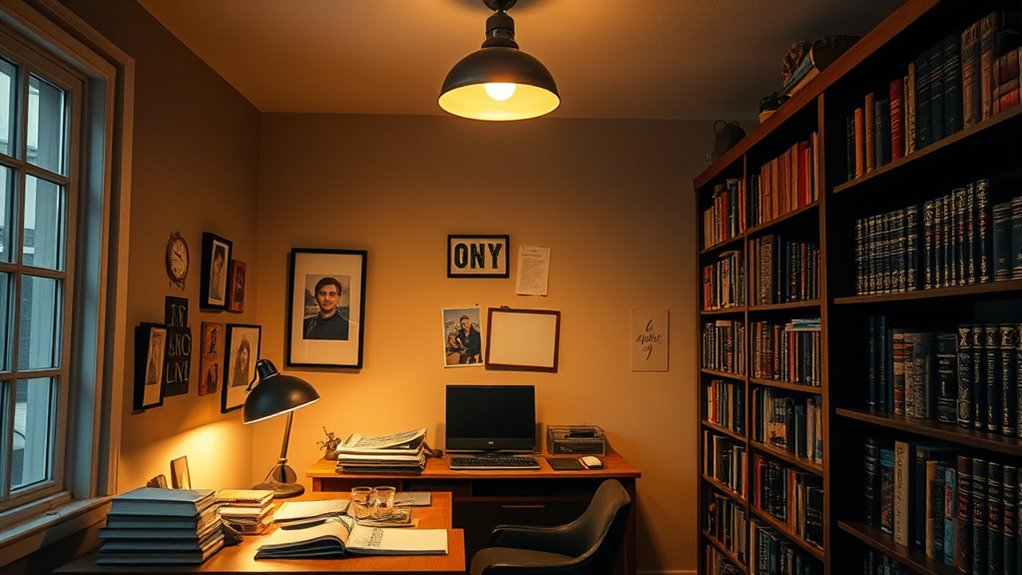To do lighting layers right, you need to balance ambient, task, and accent lights carefully. Ambient lighting sets the overall mood, so it’s soft and even without washing out details. Task lighting highlights specific areas, ensuring clarity and focus, while accent lighting adds drama by emphasizing textures or objects. When these layers work together seamlessly, your scene becomes lively, natural, and visually compelling. Keep exploring how to master each layer for stunning results.
Key Takeaways
- Achieve balanced lighting by carefully adjusting the intensity and placement of ambient, task, and accent lights.
- Use diffusers and reflectors to control ambient light and prevent flat or washed-out scenes.
- Position task lights to highlight key subjects without creating harsh shadows or overwhelming the scene.
- Employ accent lighting subtly to emphasize textures or objects, adding depth without distraction.
- Ensure all layers work harmoniously to create a natural, visually engaging scene with proper contrast and mood.

Lighting layers are a fundamental concept in photography and design, allowing you to shape the mood and depth of your images. When you understand how to use ambient, task, and accent lighting effectively, you can create scenes that feel natural, engaging, and visually compelling. Each layer serves a specific purpose, and when combined thoughtfully, they work together to enhance your subject and environment without overpowering each other.
Ambient lighting is the foundation of your lighting setup. It provides overall illumination, filling the space evenly and setting the general tone. Think of it as the natural daylight or the soft glow that bathes a room. You control ambient light through sources like windows, ceiling fixtures, or softboxes. The key is to balance it so it’s not too harsh or too dim. Too much ambient light can flatten your image, washing out details and reducing contrast. Too little, and your scene might feel dull or overly shadowed. Mastering ambient lighting involves adjusting its intensity and direction to create a pleasing background that supports your focal points without distracting from them.
Task lighting is more focused and intentional. It highlights specific areas where you need clarity, detail, or emphasis. For example, if you’re photographing a person reading, a small, directed light on their face ensures their features are clear and engaging. In a room, task lighting might be a desk lamp or a spotlight that draws attention to a particular object. When you use task lighting, you want it to be bright enough to serve its purpose but not so overpowering that it creates harsh shadows or overwhelms the scene. Position your lights carefully, paying attention to how they interact with ambient light and the mood you want to evoke.
Accent lighting adds drama and visual interest. It’s used to highlight textures, colors, or specific elements within your scene, like a piece of artwork or a decorative object. Accent lights are often more directional and can be placed behind or beside your subject to create a sense of depth or to draw the viewer’s eye. When done right, accent lighting enhances the story within your image, adding layers of complexity and intrigue. It requires subtlety—too much accent lighting can become distracting, while too little might fail to add the desired emphasis.
Frequently Asked Questions
How Do I Balance Multiple Lighting Layers Effectively?
To balance multiple lighting layers effectively, start by prioritizing the primary function of each space. Use dimmers or adjustable fixtures to fine-tune brightness levels, ensuring no layer overwhelms the others. Mix warm and cool tones to create depth, and avoid overly bright or harsh lights. Regularly evaluate your lighting during different times of day to maintain harmony, adjusting as needed for a comfortable, well-lit environment.
What Are Common Mistakes in Layering Lighting?
You often overdo it by using too many lights or choosing mismatched intensities, which creates a cluttered or unbalanced look. You might neglect the importance of dimming options or fail to take into account how natural light interacts with your layers. Avoid relying solely on one type of lighting; instead, ensure each layer complements the others. Test your setup frequently, adjusting brightness and placement for a harmonious, effective lighting scheme.
How Can I Adjust Lighting for Different Moods?
Imagine your space as a story waiting to unfold; adjusting lighting helps you set the tone. To craft different moods, subtly dim the ambient lights for intimacy or brighten them for energy. Add warm accent lights to cozy up a room or cool tones for a modern vibe. Use dimmers and flexible fixtures to effortlessly shift atmospheres, turning your environment into a canvas that responds to your mood.
What Energy-Efficient Options Exist for Layered Lighting?
You can choose LED bulbs, which use less energy and last longer, for all your lighting layers. Use dimmers to control brightness and reduce power consumption when full light isn’t needed. Opt for smart lighting systems that let you schedule and adjust settings remotely, saving energy. Incorporate natural light during the day to minimize artificial lighting. These options help you create layered lighting that’s both efficient and adaptable to different moods.
How Do I Incorporate Smart Lighting Into Layers?
You can turn your space into a futuristic haven by integrating smart lighting into your layers. Use smart bulbs or switches that let you control brightness, color, and timing with a tap or voice command. Program ambient lights to dim automatically at night, set task lighting to brighten only when needed, and add accent lights that sync with your mood or activities. It’s like having a personal lighting wizard at your fingertips!
Conclusion
By mastering the three lighting layers—ambient, task, and accent—you’ll create a space that’s both functional and inviting. Remember, lighting isn’t just about illumination; it’s about setting the mood and highlighting what’s important. When you get it right, you’re playing with fire in a good way. Don’t forget, a well-lit room can turn a house into a home—so don’t overlook the details and let your lighting truly shine.









